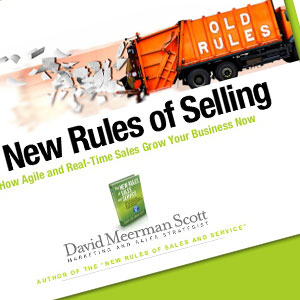You’re in sales. No, really, you are. It doesn’t matter what your exact job title is or what your main day-to-day responsibilities are, every one of us is in the business of sales. You’re selling your goods, your services, or even just your ideas. The problem? Your buyers have changed.
Thanks to technology, consumers are now more informed than ever before. Think about that for a minute. When you had to buy a car, what’s the first thing you did? Go to the dealership? I doubt it. You looked online. You did research to help you make your decision. Maybe you engaged on social media to ask friends and family what they were driving and how they liked it. When you finally did go to the dealership you were armed with the knowledge to help you make your purchase.
This paradigm shift in selling is great once you realize and accept it. You can make your business a success by shifting your focus from sales to being helpful. David Meerman Scott has whittled down the new rules of selling and all you have to do to be successful is follow these simple, straightforward rules. For more information on David Meerman Scott, or to purchase one of his fantastic books, visit http://www.davidmeermanscott.com/.
1. Authentic storytelling sets the tone
When you were looking for information on your last purchase, I’m guessing you ignored the sales brochure. You might have skimmed it, but you didn’t make a decision based on what it told you. More than likely, you were looking for real, authentic information. Information such as product reviews, comparisons, even stories from people who had purchased the product and were using it.
People want to do business with people. Did you know that 20% of new HubSpot customers viewed the co-founder and CEO Brian Halligan’s bio page before becoming a customer? They want to know there’s something real behind the website or brick-and-mortar store. Consumers are searching for the human touch that can only be found in authenticity.
2. Content is the link between companies and customers
When consumers are searching for information on a problem that your product or service can help them solve, you want to make sure they find you. That is accomplished through content. Blogs, online videos, e-books, infographics, podcasts – pick one or many! Content lets organizations communicate directly with the buyer in a form that they will appreciate.
Social networks allow consumers to connect and engage directly businesses. According to Twitter, brands that retweeted or communicated with followers experienced an 18% increase in engagement. Engagement creates trust when that engagement is authentic and helpful.
You sell more when you stop selling. Be helpful by providing information content to information searchers and they will become your buyers!
3. Big data enables a more scientific approach to sales
Consumers now have access to more information than ever before. Because of this, the people browsing your website will be at different stages in the buyer’s journey. Some might be at the very beginning just gathering information, others may be in the process of narrowing down a few selections, and still others will have made a decision and are ready to purchase now! The best organizations customize the buying experience for each customer and make it easy for them to find the information they need exactly when they’re looking for it.
When a customer is ready to purchase, they want help NOW! The organizations that are best suited and ready to handle this are using big data metrics and analytics to help predict this behavior. Every action that a potential buyer takes may be a sales signal. Visiting the pricing page of your site, opening an e-mail, even visiting your LinkedIn profile are all sales signals. When your customers are ready, will you be?
4. Agile selling brings new business to your company
Because buyers have access to more information, they want to buy on their own personal timetable. It is now up to the sellers to ask the right questions and be ready with the right answers on the buyers time. Organizations that take the time to understand the needs of their customers and take the time to educate those customers are more successful.
Blogs are one great way to help educate and reach your audience quickly. Your day-to-day activities will allow you to see the specific things impacting your customers and give you the information you need to create the content that will be helpful to your audience. It also creates a great way for you to communicate with potential and current customers through commenting.
Social media is another platform that allows fast engagement with your audience. Whatever tools you decide to use, remember that the goal with agile selling is speed – be ready with the information your buyers need when they need it.
5. Real-time engagement keeps customers happy
Technology has turned our world on 24/7. Unhappy customers who don’t get a fast answer from you will go looking for that answer elsewhere. They might leave a negative review, write a blog post about it, or talk about it on social networks for the world to see. Buyers expect instant service and organizations unable to meet those demands may get burned quickly.
Real-time engagement is not just about direct and immediate communication with your customers, it’s about seizing opportunities for your business. When news breaks about a subject that you know intimately, are you jumping on the opportunity to engage on that subject?
Below is the full presentation by David Meerman Scott on the New Rules of Selling:

